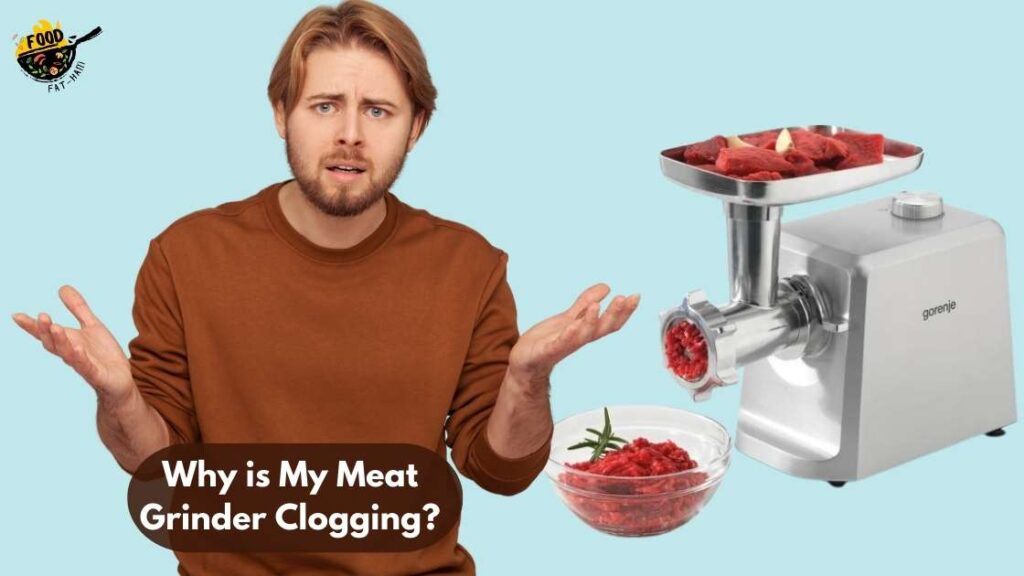Your meat grinder is likely clogging due to an excessive amount of fat or connective tissue in the meat being ground. Meat grinders can experience clogging issues when there is a buildup of fat or connective tissue in the meat.
Table of Contents
ToggleThese substances can stick to the blades and auger, inhibiting the smooth flow of meat through the grinder. Overloading the grinder with too much meat at once can also contribute to clogging. To prevent clogging, it is important to trim excess fat from the meat and cut it into smaller, more manageable pieces before grinding.
Regular cleaning and maintenance of the grinder are also crucial to keep it in optimal working condition. By following these steps, you can ensure a smooth and efficient grinding process.
Understanding Meat Grinder Clogging
Meat grinder clogging can be caused by various factors. From using low-quality meat to insufficient cleaning, understanding why your meat grinder clogs is essential for a smooth grinding experience. Explore common causes and solutions to keep your grinder running efficiently.
Clogging is a common issue faced by meat grinder users, and it’s important to understand the factors contributing to this problem to address it promptly. When your meat grinder gets clogged, it can be frustrating and can hinder your cooking process.
To help you understand this issue better, let’s delve into the common problems faced by meat grinder users and the key factors that contribute to clogging.
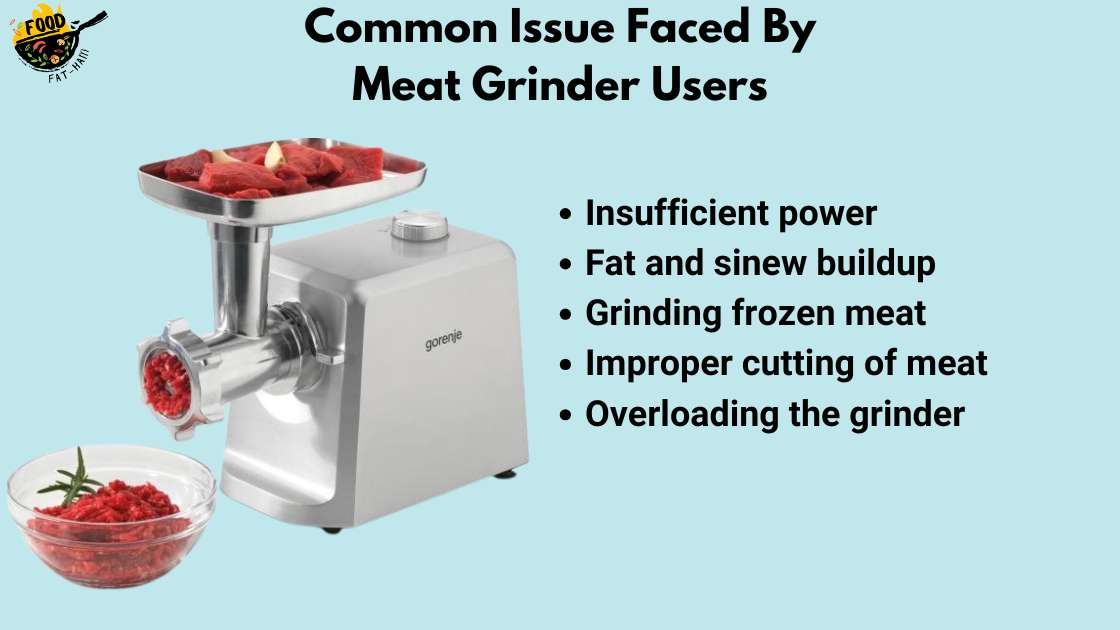
Common Issue Faced By Meat Grinder Users
- Insufficient power: Some meat grinders may lack the necessary power to grind tougher cuts of meat, leading to clogging.
- Fat and sinew buildup: Fatty meats or meats with sinew can cause clogging as the grinder struggles to process these tougher parts.
- Grinding frozen meat: Attempting to grind frozen meat can be a common mistake that leads to clogging, as it can overwhelm the grinder’s motor and cause it to jam.
- Improper cutting of meat: If the meat is not properly sliced into smaller pieces before grinding, it can put excessive strain on the grinder and result in clogging.
- Overloading the grinder: Overloading the grinder with too much meat at once can overwhelm its capacity and cause clogging.
Importance Of Identifying And Addressing The Problem Promptly
- Prevents damage to the grinder: When a meat grinder gets clogged, it puts excessive strain on the motor and other components. Identifying and addressing the clogging issue promptly can prevent long-term damage to the grinder.
- Maintains food safety: If the meat grinder gets clogged with partially ground meat, it can lead to bacterial growth and compromise the safety of the meat. Promptly resolving the clogging issue helps maintain food safety standards.
- Saves time and effort: Dealing with a clogged meat grinder can be time-consuming and frustrating. By identifying and addressing the problem promptly, you can save time and effort in the long run.
Key Factors Contributing To Clogging
- Size of grinder plate holes: When the holes on the grinder plate are too small, it can result in clogging as the meat struggles to pass through.
- Dull or damaged blades: Blades that are dull or damaged can make the grinding process inefficient, leading to clogging.
- Inadequate cleaning and maintenance: Neglecting regular cleaning and maintenance of your meat grinder can cause clogging as residual meat or fat accumulates over time.
- Incorrect assembly: If the grinder is not properly assembled, it may not function optimally, resulting in clogging.
- Low-quality meat: Low-quality meat with excessive connective tissue or tough fibers can contribute to clogging issues.
Understanding the common issues faced by meat grinder users, the importance of addressing clogging promptly, and the key factors contributing to clogging will help you take appropriate measures to prevent and resolve this problem efficiently. By maintaining your meat grinder properly and being mindful of the factors mentioned, you can ensure a smooth and hassle-free grinding experience.
The Role Of Fat In Meat Grinder Clogging
Fat plays a significant role in the clogging of meat grinders, as it can solidify and accumulate within the machine. Regular cleaning, proper meat preparation, and adding ice cubes while grinding can help prevent clogging issues.
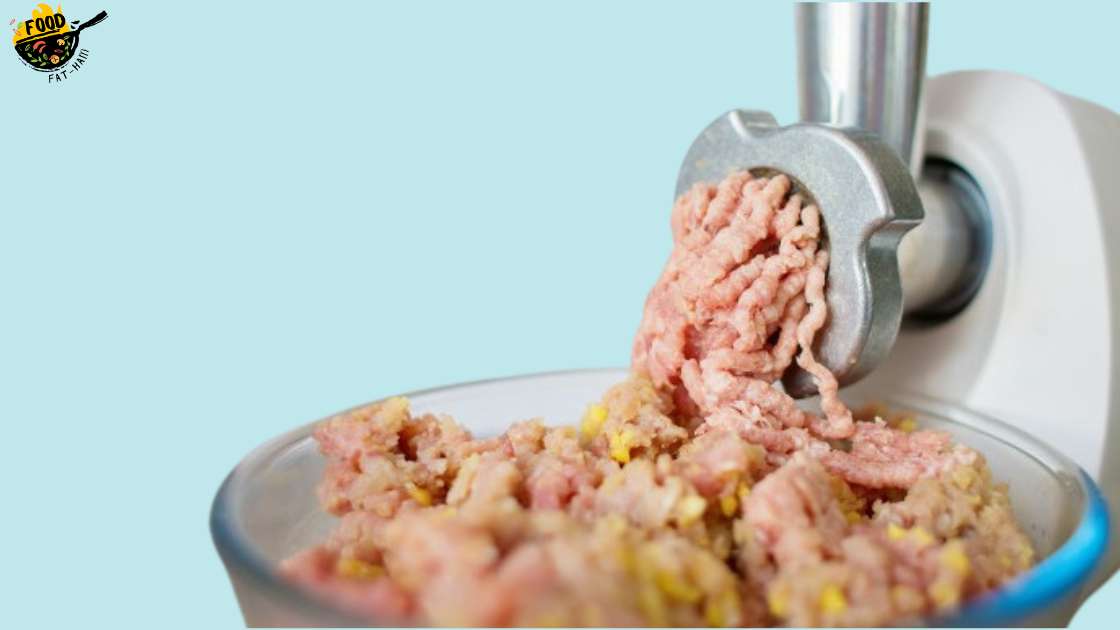
The Impact Of Fatty Meats On Clogging
Clogging in meat grinders can be a frustrating issue that many home cooks and professional chefs encounter. One of the major culprits behind this problem is fat. The high fat content in certain meats can cause blockages and make the grinding process a difficult and messy affair.
Understanding the role of fat in meat grinder clogging is essential for finding effective solutions to this issue.
Understanding The Composition Of Fat In Meat
To comprehend why fatty meats are prone to clogging meat grinders, it’s important to delve into the composition of fat. Fat in meat is primarily made up of triglycerides, which are molecules comprising glycerol and fatty acids. Triglycerides vary in consistency depending on the type of fatty acid present, ranging from liquid (oils) to solid (fats) at room temperature.
The more fat a meat contains, the more likely it is to cause clogging in the grinder.
When meats with higher fat content are ground, the fat particles smear and stick to the blades and auger. This accumulation of fat can gradually impede the proper functioning of the grinder, leading to blockages and difficulty in producing ground meat consistently.
Strategies To Minimize Fat-Related Clogging
Fortunately, there are several strategies you can employ to minimize fat-related clogging in your meat grinder.
By implementing these practices, you can ensure a smoother grinding process and avoid the frustration of constant blockages:
- Choose leaner cuts of meat: Opt for lean cuts with a lower fat content. Lean meats are less likely to cause clogging, making the grinding process more efficient.
- Partially freeze the meat: Before grinding fatty meats, consider partially freezing them. This helps to solidify the fat, making it less likely to smear and stick to the grinder’s components. However, avoid freezing the meat completely, as it may become too hard to grind.
- Trim excess fat: Remove any excess visible fat from the meat before grinding. By trimming off excess fat, you can significantly reduce the likelihood of clogging and ensure a smoother grinding experience.
- Alternate between fatty and lean meats: If you prefer using fatty meats, try alternating between fatty and lean cuts while grinding. This can help prevent excessive fat buildup and reduce the chances of clogging.
- Clean the grinder thoroughly: Regularly cleaning your meat grinder is essential for preventing fat accumulation and maintaining its optimal performance. Disassemble the grinder and clean all the components thoroughly after each use.
By implementing these strategies and being mindful of the fat content in the meat you grind, you can minimize the risk of clogging your meat grinder. Enjoy hassle-free grinding, and create delicious ground meat for your favorite recipes!
Moisture Content: A Hidden Culprit
Discover the hidden culprit behind your clogged meat grinder: moisture content. Excess moisture can cause the meat to stick, leading to frustrating blockages.
Find out how to prevent this common issue and ensure smooth grinding every time.
The Influence Of Moisture On Clogging
Moisture content plays a significant role in meat grinder clogging. Excessive moisture can cause the meat to stick together, creating a dense and sticky mixture that is difficult for the grinder to process. Understanding the influence of moisture on clogging is essential in preventing this frustrating issue.
Here are some key points to consider:
- Moisture creates clumps: When the meat is too moist, it tends to clump together, creating large compact pieces that can block the grinder’s blades. These clumps are harder to process and can put stress on the grinder’s motor, leading to clogging.
- Meat fat and water proportion: The fat and water content in meat significantly affect its texture. If the meat is too fatty or has excess water, it can result in an overly wet mixture, making it challenging for the grinder to handle.
- Types of meat and moisture: Different types of meat have varying moisture content, and this can affect the likelihood of clogging. For example, poultry meat generally has a higher moisture content than lean beef, making it more prone to clogging issues.
Tips To Regulate Moisture Content In Meat
Regulating the moisture content in your meat is crucial for preventing clogging and ensuring a smooth grinding process.
Here are some helpful tips to maintain the optimal moisture balance:
- Proper chilling: Before grinding, ensure that the meat is properly chilled. Cold meat tends to retain less moisture during grinding, resulting in a dryer mixture that is easier to process.
- Trimming excess fat: Removing excessive fat from the meat not only improves the texture but also reduces the overall moisture content. This helps prevent clogging, as fat tends to release more moisture during grinding.
- Choosing appropriate meat cuts: Opt for leaner cuts of meat with lower water content. These cuts are less likely to generate excess moisture and clump together during grinding.
- Adding dry ingredients sparingly: When adding additional ingredients to your ground meat mixture, such as breadcrumbs or spices, use them sparingly. Dry ingredients can absorb moisture and help maintain a dryer consistency.
- Avoiding excessive seasoning: While seasoning is essential for flavor, excessive use of liquid-based marinades or brines can increase moisture content. Use seasoning in moderation to prevent an overly wet mixture.
Preventive Measures For Excessive Moisture
Taking preventive measures can go a long way in avoiding excessive moisture, which is a hidden culprit behind meat grinder clogging.
Follow these preventive steps to keep moisture-related issues at bay:
- Dry your meat thoroughly: Before grinding, make sure to pat the meat dry with paper towels to remove any excess moisture on the surface.
- Control the grinder speed: Running the grinder at high speeds can create heat, causing the meat to release more moisture. Use a lower speed setting to minimize the moisture content.
- Grind smaller batches: Avoid overloading the grinder with excessive amounts of meat. Grinding in smaller batches helps maintain control over the moisture content and ensures a more efficient grinding process.
- Clean and dry the grinder thoroughly: After each use, clean and dry the grinder thoroughly to eliminate any moisture residue. This prevents the accumulation of moisture in subsequent grinding sessions.
By understanding the influence of moisture on clogging, following tips to regulate moisture content, and implementing preventive measures, you can ensure a hassle-free meat grinding experience. Be mindful of balancing the moisture levels in your meat, allowing your grinder to work efficiently without any clogging issues.
Bone Fragments: Unexpected Obstruction
Bone fragments can unexpectedly clog your meat grinder, causing obstruction. Don’t fret! We’ve got you covered with reasons why this happens and tips to prevent it from happening again.
Bone-Related Challenges In Meat Grinding
Grinding your own meat at home can be a rewarding and cost-effective way to enjoy freshly ground meat. However, one common challenge that many meat grinder users face is clogging. Most people might assume that clogs are caused by fat or sinew, but bone fragments can also be an unexpected obstruction.
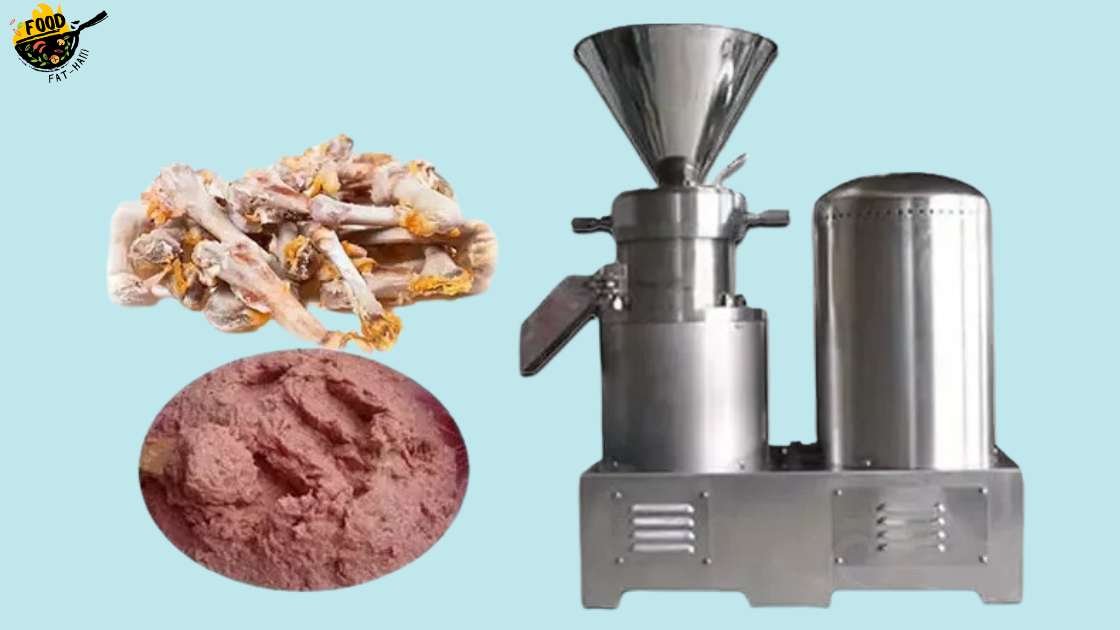
In this section, we will delve into the issue of bone-related clogs, how to identify bone fragments in the meat, and techniques to avoid such clogs.
Identifying Bone Fragments In The Meat:
The presence of bone fragments in your ground meat can not only lead to clogging in your meat grinder, but it can also pose safety hazards when consuming the meat.
Here are some ways to identify bone fragments:
- Look for irregularities: Bone fragments can often have sharp edges or irregular shapes, which may be visible when examining the meat.
- Pay attention to texture: Grinding bone can create a gritty texture in the meat, which may indicate the presence of bone fragments.
- Check for small hard particles: If you come across small hard particles while grinding, it could be bone fragments.
Techniques To Avoid Bone-Related Clogs
To prevent bone-related clogs and ensure a smoother grinding process, here are some techniques you can follow:
- Remove bones prior to grinding: Before grinding the meat, take the time to carefully remove any bones. This step will significantly reduce the chances of bone fragments causing clogs.
- Use lean cuts of meat: Opt for lean cuts of meat that have minimal bone content. This will minimize the risk of bone fragments getting into the grinder.
- Cut meat into smaller pieces: Cutting the meat into smaller pieces before grinding can help break down any bone fragments that may be present, reducing the risk of a clog.
- Slow and steady feeding: When feeding the meat into the grinder, do it slowly and steadily. This allows the grinder to process the meat and any bone fragments more efficiently, reducing the likelihood of clogging.
- Clean the grinder regularly: Regularly cleaning your meat grinder is crucial to prevent clogs. Bone fragments can accumulate and become lodged in hard-to-reach areas, so thorough cleaning after each use is essential.
By being aware of the potential for bone-related clogging, identifying bone fragments in the meat, and following these techniques to avoid such clogs, you can enjoy a hassle-free meat grinding experience.
Remember, taking the necessary precautions will ensure not only the longevity of your meat grinder but also the safety and quality of the ground meat you prepare.
Skin And Connective Tissue: Sneaky Culprits
Discover the sneaky culprits behind clogged meat grinders: skin and connective tissue. These stubborn elements can wreak havoc on your machine, causing frustration and delays in your food preparation. Uncover effective tips to prevent clogging and maintain your meat grinder’s efficiency.
The Role Of Skin And Connective Tissue In Clogging
As you fire up your meat grinder and prepare to make some delicious homemade sausages or ground meat, you may encounter a frustrating issue – clogging. One of the sneaky culprits behind this common problem is skin and connective tissue.
Let’s take a closer look at why these two elements play a role in clogging your meat grinder, how to evaluate their presence in the meat and effective methods for processing them.
Evaluating The Presence Of Skin And Tissue In The Meat
- Visual inspection: Examine the meat carefully before grinding. Look for the presence of visible skin and connective tissue. These can appear as tough, fibrous strands or thin, translucent layers.
- Texture and consistency: Gently press and feel the meat. Skin and connective tissue can create a distinct chewiness or firmness that differs from the rest of the meat.
- Fat content: Skin and connective tissue often have a higher fat content compared to lean meat. If you notice an uneven distribution of fat or streaks, it could indicate the presence of these elements.
Effective Methods For Processing Skin And Tissue
- Pre-trimming: Before grinding the meat, remove any visible skin or excessive connective tissue with a sharp knife. This initial step can prevent clogging issues and improve the overall texture of the final product.
- Partial grinding: If the meat contains moderate amounts of skin and connective tissue, consider using a coarse grinding plate initially. This process helps break down the elements into smaller pieces, reducing the risk of clogging the grinder.
- Alternate grinding: For large batches of meat with substantial skin and connective tissue, alternate between grinding the meat alone and grinding it with added fat or lean meat. This method helps the grinder handle tougher elements more easily.
Now that you understand the role of skin and connective tissue in clogging your meat grinder, as well as methods for evaluating and processing them, you can approach your grinding tasks more effectively. Remember to always clean and maintain your grinder properly to ensure optimal performance.
Grinder Plate Size: Finding The Right Fit
Having the right size grinder plate is crucial for avoiding clogs in your meat grinder. Choose the appropriate size to ensure smooth operation and consistent results.
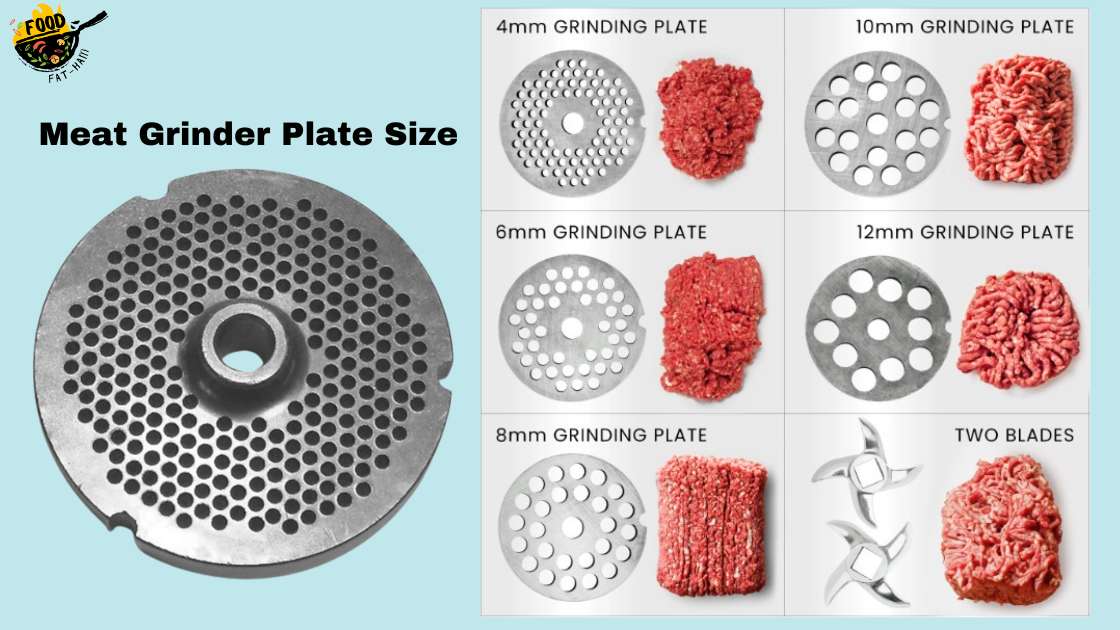
Have you ever wondered why your meat grinder keeps clogging up? Well, one possible culprit could be the size of your grinder plate. The grinder plate, which is the part of the grinder that actually grinds the meat, can have a significant impact on whether or not your grinder clogs.
Let’s delve deeper into the impact of grinder plate size on clogging, how to determine the ideal plate size for different meat cuts, and compare plate options for optimal grinding.
Impact Of Grinder Plate Size On Clogging
The size of the grinder plate can directly affect how smoothly your meat grinds, potentially leading to clogs if not chosen correctly.
A small grinder plate with fine-sized holes can easily become overwhelmed with large chunks of meat, causing the grinder to clog.
On the other hand, a larger grinder plate with larger holes may not provide enough resistance for smaller cuts of meat, leading to mushy results and potential clogs.
It’s crucial to find the right balance between the size of the grinder plate holes and the type and size of meat you are working with to prevent clogging and achieve the desired texture.
Determining The Ideal Plate Size For Different Meat Cuts
When it comes to choosing the right grinder plate size, considering the type and cut of meat you plan to grind is essential.
Here are some guidelines to help you determine the ideal plate size for different meat cuts:
For lean cuts like beef and venison, a smaller grinder plate with finer holes (around 1/8-inch) works best to achieve a smooth and even texture.
For fatty cuts such as pork or lamb, a larger grinder plate with slightly bigger holes (around 3/16 to 1/4-inch) can help prevent clogs caused by fat accumulation.
For poultry and fish, which tend to have a softer texture, using a smaller plate size (around 1/8 to 3/16-inch) can help maintain the meat’s integrity during the grinding process.
Ultimately, experimenting with different plate sizes and observing the grinding results will give you a better understanding of which size works best for the specific cuts of meat you are using.
Comparing Plate Options For Optimal Grinding
- Fine (1/8-inch) plate: Ideal for lean cuts and achieving a smooth texture.
- Medium (3/16 to 1/4-inch) plate: Suitable for fatty cuts, preventing clogs caused by built-up fat.
- Coarse (1/2 to 3/4-inch) plate: Great for creating a chunkier texture, commonly used for grinding meat for sausages and stews.
- Specialty plates: Some grinder models offer specialty plates with different hole patterns or sizes, allowing you to experiment and customize your grinding results.
By choosing the right grinder plate size for your specific needs, you can ensure optimal grinding and reduce the chances of clogging. Experimenting with different plate sizes and observing the results will help you find the perfect fit for each type of meat you plan to grind.
So, get ready to enjoy hassle-free and efficient meat grinding with the right grinder plate size.
Overloading: The Culprit In Capacity
Meat grinders clog due to overloading, which can overwhelm the capacity of the machine. This common issue can be avoided by not exceeding the recommended amount of meat during grinding.
The Role Of Overloading In Meat Grinder Clogging
When it comes to using a meat grinder, one of the most frustrating issues that can arise is clogging. If you’ve ever experienced this, you know that it can bring your grinding session to a halt and leave you wondering what went wrong.
One common culprit behind meat grinder clogging is overloading. Understanding the impact of overloading and the limitations of your grinder’s capacity is crucial in preventing this issue.
Understanding The Grinder’s Capacity Limitations
A meat grinder, no matter how powerful it may be, has its limits. Overloading it with excessive amounts of meat or other ingredients can put excessive strain on the grinder’s motor and blades, leading to clogs.
Here are a few key points to keep in mind when it comes to understanding your grinder’s capacity:
- Grinder Size: Different meat grinders come in varying sizes and power capacities. Each grinder model has a recommended maximum quantity of meat it can handle at one time. Exceeding this capacity is one of the leading causes of clogging.
- Motor Power: The power of the grinder’s motor directly affects its capacity. Higher-powered motors can handle larger quantities of meat or tougher cuts with ease, reducing the risk of clogging.
- Cutting Plate Size: Choosing the appropriate cutting plate size is essential. Smaller plate sizes can lead to faster clogs, especially if you’re trying to process large quantities of meat in one go.
Tips To Prevent Overstuffing And Clogging
Now that you have a clear understanding of the role overloading plays in meat grinder clogging and the limitations of your specific grinder, here are some practical tips to prevent overstuffing and subsequent clogging:
- Cut Meat into Smaller Pieces: Before grinding, it’s crucial to cut the meat into smaller chunks. This not only makes it easier for the grinder to process but also helps ensure a more consistent and efficient grinding experience.
- Feed Gradually: Avoid the temptation to dump all the meat in at once. Instead, feed it in gradually, allowing the grinder to process each portion fully before adding more. This will help in preventing overloading and clogging.
- Remove Excess Fat and Connective Tissues: Trim off excess fat and remove any tough connective tissues before grinding. These elements can cause clogging and put unnecessary strain on the grinder’s motor and blades.
- Alternate with Smaller Ingredients: If you’re grinding other ingredients along with meat, alternate between adding small amounts of meat and the additional ingredients. This allows for better distribution and reduces the likelihood of overloading.
- Regular Maintenance: To ensure proper performance and minimize the risk of clogging, regular cleaning and maintenance of your meat grinder are essential. Follow the manufacturer’s instructions for disassembling, cleaning, and lubricating the grinder’s components.
By adhering to these tips and understanding the limitations of your meat grinder, you can significantly reduce the risk of overloading and clogging. Remember, proper usage and maintenance are key to a smooth grinding experience.
Maintenance Matters: Keeping Clogs At Bay
Discover the reasons behind meat grinder clogging and how proper maintenance can prevent this frustrating issue. Keep your meat grinder in top shape with these helpful tips and say goodbye to clogs for good.
Regular cleaning and maintenance routine
To prevent your meat grinder from clogging, it’s essential to establish a regular cleaning and maintenance routine.
By doing so, you ensure that your grinder stays in optimal condition and operates smoothly every time you use it.
Here are a few key points to keep in mind:
- After every use, disassemble the grinder and remove any remaining meat or gristle. You can use a small brush or toothbrush to thoroughly clean the blades, plates, and other components. This step helps prevent the buildup of residue and minimizes the risk of clogs.
- Inspect the grinder’s parts for any signs of wear and tear, such as dull blades or cracked plates. If you notice any damage, replace these components immediately to maintain the grinder’s efficiency.
- Regularly check the grinder’s motor and drive system for any indications of malfunction or unusual noises. Ensure that all connections are secure and tighten any loose screws. Any issues with the motor or drive system can contribute to clogging problems, so addressing them promptly is crucial.
Effective cleaning techniques for different grinder parts
Now, let’s take a closer look at the cleaning techniques you can employ for each specific meat grinder part:
- Blades: After disassembling the grinder, remove the blades and soak them in warm, soapy water for a few minutes. Gently scrub them with a sponge or brush to remove any remaining debris. Rinse thoroughly and dry before reassembling.
- Plates: Similar to blades, soak the plates in warm, soapy water to loosen any meat or fat residue. Use a soft brush to clean the surface, paying particular attention to the small holes. Rinse well and dry thoroughly.
- Auger: The auger is one of the critical components responsible for pushing meat through the grinder. To clean it effectively, use warm, soapy water and a long brush to remove any meat particles or grease. Rinse it thoroughly and ensure it is completely dry before reattaching.
- Housing and hopper: Wipe the housing and hopper with a damp cloth to remove any residue. Avoid using excessive water, as it can damage the grinder’s motor. After wiping, dry them thoroughly.
Steps for proper lubrication and upkeep
Proper lubrication and upkeep are vital for ensuring that your meat grinder functions optimally and avoids clogs.
Follow these steps to keep your grinder in excellent working condition:
- Lubrication: Apply a food-grade lubricant to the grinder’s moving parts, such as the auger and gears, as recommended by the manufacturer. This ensures smooth operation, reduces friction, and minimizes the chances of clogs.
- Storage: When not in use, it’s essential to store your meat grinder properly. Disassemble all removable parts and clean them thoroughly. Ensure that everything is completely dry before storing in a cool, dry place. This practice helps prevent the growth of bacteria and extends the lifespan of your grinder.
- Regular inspection: Regularly inspect your meat grinder for any signs of damage, wear, or malfunction. If you observe any issues, address them promptly to avoid more significant problems down the line.
Remember, by implementing a regular cleaning and maintenance routine, utilizing effective cleaning techniques, and taking proper steps for lubrication and upkeep, you can keep clogs at bay and enjoy a hassle-free meat-grinding experience.
Choosing The Right Grinder: Factors To Consider
Clogging in your meat grinder can be frustrating, but choosing the right grinder can help prevent this issue. Factors to consider include the power of the motor, the size of the grinding plate, and the quality of construction.
The Significance Of Selecting A Suitable Meat Grinder
Choosing the right meat grinder is crucial to prevent clogs and ensure smooth operation. There are several factors to consider when selecting a grinder that will meet your needs and minimize the risk of clogging.
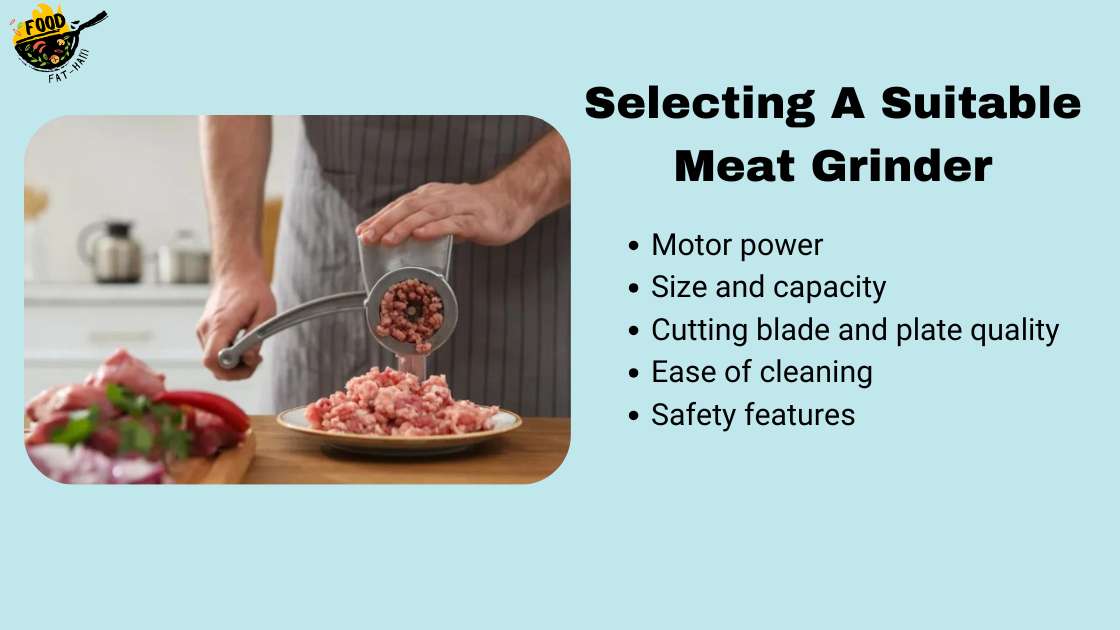
Let’s take a look at the key features to consider for clog-free operation:
- Motor power: A powerful motor is essential for grinding meat without clogging. Look for a grinder with a motor that has sufficient horsepower to handle the volume and density of meat you plan to grind.
- Size and capacity: Consider the size and capacity of the grinder based on your specific needs. If you regularly process large quantities of meat, opt for a larger grinder that can handle the workload without getting overwhelmed.
- Cutting blade and plate quality: The quality of the cutting blade and plate can greatly impact the grinding process. Look for grinders with sharp, durable blades and plates to ensure efficient grinding and minimize the chances of clogging.
- Ease of cleaning: Cleaning the meat grinder is an important step to prevent clogs. Choose a grinder that is easy to disassemble and clean, with components that can be easily washed and dried thoroughly.
- Safety features: Safety should always be a priority when using a meat grinder. Look for grinders with safety features such as a reverse function, overload protection, and a sturdy build to withstand heavy usage.
Evaluating meat grinder options based on your specific needs will help you find the perfect grinder that minimizes clogging issues. Consider factors such as motor power, size and capacity, cutting blade and plate quality, ease of cleaning, and safety features to ensure a smooth and hassle-free grinding experience.
Remember, choosing the right grinder is the first step in preventing clogs and achieving optimal performance.
Common Misconceptions And Troubleshooting Tips
Are you frustrated with your meat grinder clogging up? Discover common misconceptions and troubleshooting tips to understand why this may be happening and how to fix it. Get expert advice to keep your meat grinder running smoothly.
Dispelling Myths About Meat Grinder Clogging
Meat grinders are prone to clogging, but understanding the common misconceptions can help prevent this frustrating issue.
Here are a few myths debunked:
- Myth: The meat grinder is defective.
- Explanation: In most cases, a clogged grinder is not a malfunction. It is often caused by improper usage or maintenance.
- Myth: Only low-quality grinders get clogged.
- Explanation: Even high-quality grinders can clog if not used correctly. The quality of the grinder doesn’t guarantee immunity from clogging.
- Myth: The blade or plate is dull.
- Explanation: A clogged grinder doesn’t necessarily mean the blade or plate is dull. Clogging can occur due to other factors, such as excessive fat or connective tissue in the meat.
- Myth: Grinding large quantities at once will prevent clogging.
- Explanation: Grinding too much meat at once can actually increase the chances of clogging. It is best to grind smaller batches to allow the grinder to handle the meat more efficiently.
Troubleshooting Techniques For Resolving Clogs
Clogs can be frustrating, but there are several troubleshooting techniques to help resolve the issue.
Here are some effective tips:
- Use chilled meat: Grinding meat that is slightly chilled can prevent clogging as it reduces the likelihood of fat smearing and sticking to the grinder’s components.
- Trim excess fat and connective tissue: Removing excess fat and tough connective tissue before grinding can prevent clogs by reducing the strain on the grinder and its components.
- Cut meat into smaller pieces: Cutting the meat into smaller chunks before feeding it into the grinder can make the grinding process smoother and reduce the likelihood of clogs.
- Clean and maintain the grinder regularly: Regular cleaning and maintenance of the grinder can prevent clogs by removing any residue or buildup that could lead to blockages.
- Use the reverse function: If your grinder has a reverse function, utilize it when you encounter a clog. This can help clear any stuck meat and allow the grinder to resume its normal operation.
- Adjust the grinding speed: Grinding at a slower speed can reduce the likelihood of clogs, especially when dealing with tougher cuts of meat. Experiment with different speeds to find the optimal setting for your specific meat grinder.
Addressing Common Issues Faced By Users
While clogs can happen for various reasons, there are a few common issues that users often encounter.
Here’s how to address them:
Issue: Grinder becomes slow or fails to start.
Solution: Check the power source and make sure the grinder is securely plugged in. Additionally, inspect the motor for any signs of damage or overheating.
Issue: Grinder produces unevenly ground meat.
Solution: Ensure that the blade and plate are properly aligned and securely in place. Also, make sure the meat is evenly distributed when feeding it into the grinder.
Issue: Meat gets stuck between the blade and the plate.
Solution: Remove any stuck meat by using a small brush or a toothpick to dislodge it gently. Then, clean and lubricate the grinder’s components.
Issue: Excessive noise during the grinding process.
Solution: The excessive noise could be due to worn-out or damaged parts. If this occurs, it may be necessary to replace the affected components or seek professional assistance.
Remember, proper usage, regular maintenance, and troubleshooting techniques are key to preventing and resolving meat grinder clogging issues. By dispelling common myths and understanding how to address these problems, you can enjoy uninterrupted and efficient grinding experiences.
Frequently Asked Questions For Why Is My Meat Grinder Clogging
Why Is My Grinder Mushing The Meat?
Your grinder may be mushing the meat due to a dull blade or incorrect settings.
What Is The Black Stuff Coming Out Of My Meat Grinder?
The black stuff coming out of your meat grinder is likely excess meat residue.
Do You Need To Lubricate A Meat Grinder?
Yes, it is necessary to lubricate a meat grinder regularly for optimal performance.
How Many Times Should You Run Meat Through A Grinder?
You should run meat through a grinder multiple times for better texture and consistency.
Conclusion
A meat grinder clogging can be a frustrating problem for any home cook or butcher. However, with a few simple tips and tricks, you can easily prevent and resolve this issue. Firstly, ensure that you are using the correct grind plate and cutting blades for the type of meat you are processing.
Secondly, make sure to keep the meat and the grinder parts cold by chilling them in the freezer before grinding. Additionally, cutting the meat into smaller pieces and feeding it gradually into the grinder can help prevent clogs. Lastly, regular cleaning and maintenance of the grinder, including removing any built-up grease or residue, will keep it running smoothly.
By following these steps, you can enjoy hassle-free meat grinding without the inconvenience of clogs. So, keep these tips in mind and get the most out of your meat grinder for delicious homemade recipes.

